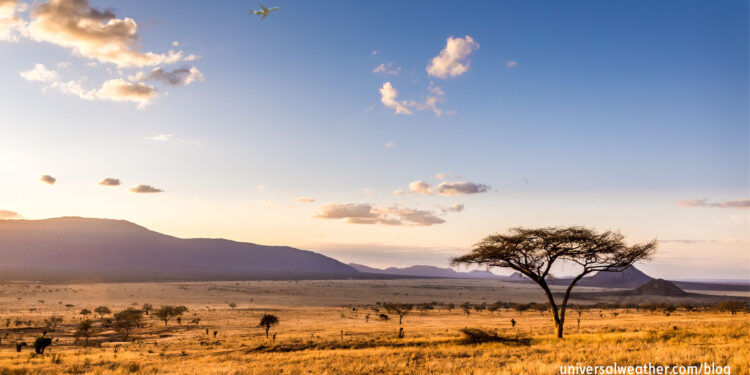Business Jet Ops to Kenya: Flight Planning, Weather & NOTAMs

This is a post by author Victoria Swai. Victoria is a permits officer for Kilimanjaro Aviation Logistics Centre (KALC), a subsidiary of Universal Weather and Aviation, Inc. which is headquartered in Mwanza, Tanzania. Victoria is an expert on permits for the African region and can be contacted at victoriaswai@universalaviation.aero.
This business aviation blog post continues from our previous article, entitled “Business Jet Ops to Kenya: Flight Permits & Slots.”
When conducting bizav ops to Kenya, you don’t need to show documentation to Air Traffic Control (ATC) in order to file a flight plan. Kenyan authorities, however, require a special form to be used in order to successfully file a compliant and valid flight plan. Also, there are a couple of weather conditions to look out for when traveling to this country.
The following is an overview of what you need to know:
1. ATC procedures
Flight plans must always be filed at least 30 minutes prior to operation. It’s also important to ensure that your landing permit confirmation is noted in remarks section 18 of the International Civil Aviation Organization flight plan when operating into or intra Kenya. ATC always checks to make sure that your flight plan schedule and routing match what was requested and obtained for your permit. For departure from Kenya, flight plans may be filed by your 3rd-party provider or ground handler. Should the Pilot in Command (PIC) choose to file the flight plan on his/her own, he or she will need to go to the ATC office to complete this step.
2. Flight plan considerations
When operating to/from Kenya, you should submit flight plans via Aeronautical Fixed Telecommunication Network. Alternatively, the PIC should submit them in person at the airport flight plan office. Note that Kenyan ATC mandates that aircraft be equipped with all standard onboard equipment. If the PIC files a flight plan in person, he/she will then go through security screening and proceed to the aircraft to prep for departure.
3. Nav fees must be paid
It’s imperative that all navigation fees associated with your flight to Kenya be paid prior to departing the country. Be sure to obtain a receipt for this payment as ATC needs to confirm that nav fees have been settled before authorities will validate your flight plan. With prior arrangement your ground handler can extend credit and invoice you for these charges at a later date. Should crew members wish to take care of nav fee payment on their own, they have to go to the airport authority office to do so. Note that nav fees may be paid only in cash.
4. Flight plan revisions
Be mindful that if you have a departure delay or change to your itinerary, the flight plan must be updated. Always ensure that your permit confirmation accurately reflects any changes to the schedule.
5. Flight and routing restrictions
Note that flights to/from Somalia require special – advance – permission from the Kenyan Ministry of Foreign Transport and Communication. Note that this permission cannot be applied for or obtained by your 3rd-party provider. In all cases operators must secure this approval either on their own or via a local contact in Kenya.
6. Tech stops
For tech stops in Kenya, crew members should ask their ground handler to pre-file their flight plan for the outbound leg. It’s important to do this prior to landing in Kenya to ensure that the flight plan is filed at least 30 minutes prior to departure. To avoid issues on departure, following a quick-turn tech stop, ensure that your ground handler has settled all nav fees owed prior to filing your flight plan.
7. Weather considerations
While Kenya rarely experiences local weather issues severe enough to close airport arrivals/departures, weather conditions can change frequently. It’s always best to obtain weather updates for your travel to/from Kenya 24 hours prior to operation. Note that the rainy season throughout most of Kenya is April-July, and fog conditions may be present May-July. Hottest months in Kenya, when temperatures can exceed 35°C, are January and February. It’s during this hot season that most tourism takes place in the country as this is the period when local wildlife migrates.
8. Weather resources
Meteo weather offices are located at all major airports, including domestic fields. If you need a weather briefing or Notice to Airmen (NOTAM), you can obtain these free of charge from these offices.
9. NOTAM considerations
Authorities in Kenya are diligent in ensuring that NOTAMs are promptly published for any issues that may arise at an airport – including temporary runway closures, fuel shortages, and/or parking unavailability due to large local events. Kenya Civil Aviation Authority maintains and constantly updates a website with all current NOTAMs.
10. Additional reading: Business Aircraft Ops to Kenya – Series Index
Note: Links will be updated as articles are published.
- Part 1 – Airport operations
- Part 2 – Ground handling
- Part 3 – Fuel, security, and additional services
- Part 4 – CIQ
- Part 5 – CIQ, documentation, and tech stops
- Part 6 – Permits and slots
- Part 7 – Flight planning, weather, and NOTAMs
- Part 8 – Hotels and local area
Conclusion
For general aviation operations to Kenya, it’s recommended that crew arrive at the airport early on day of departure. You’ll benefit from additional lead time prior to departure, in order to clear security screening, check on latest NOTAMs and weather, and settle all nav fees due.
Later, we’ll discuss hotels and local area information for Kenya and their impact on your trip.
Questions?




